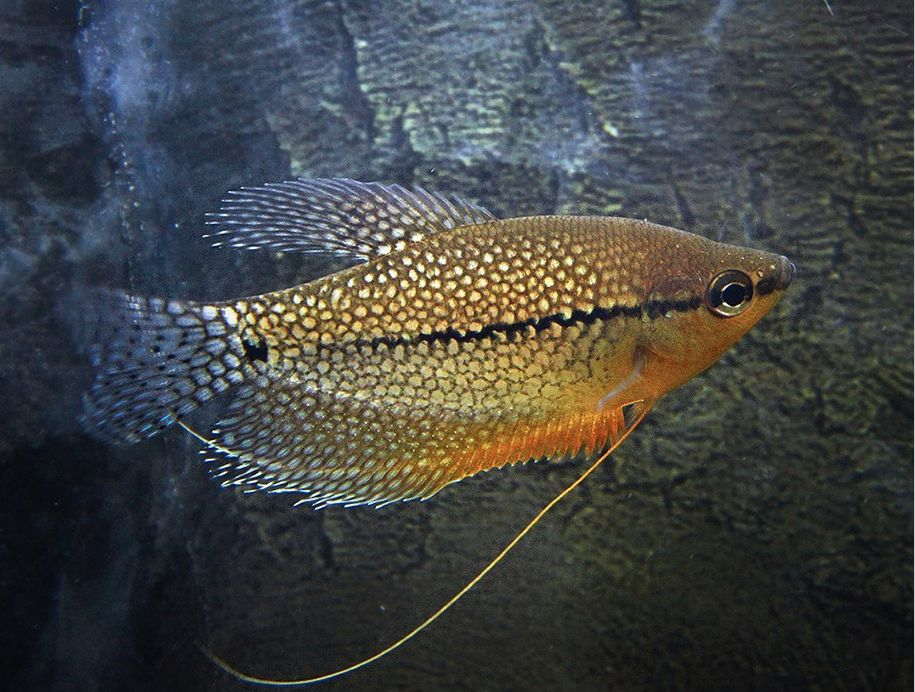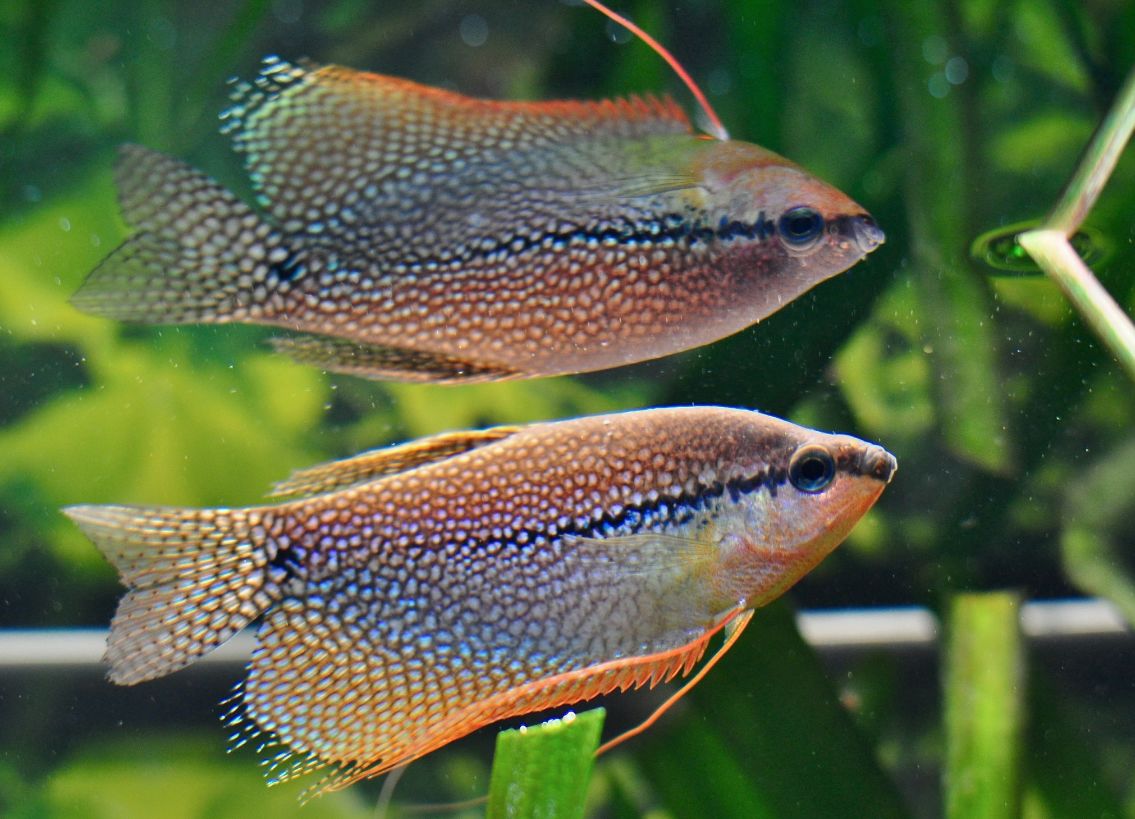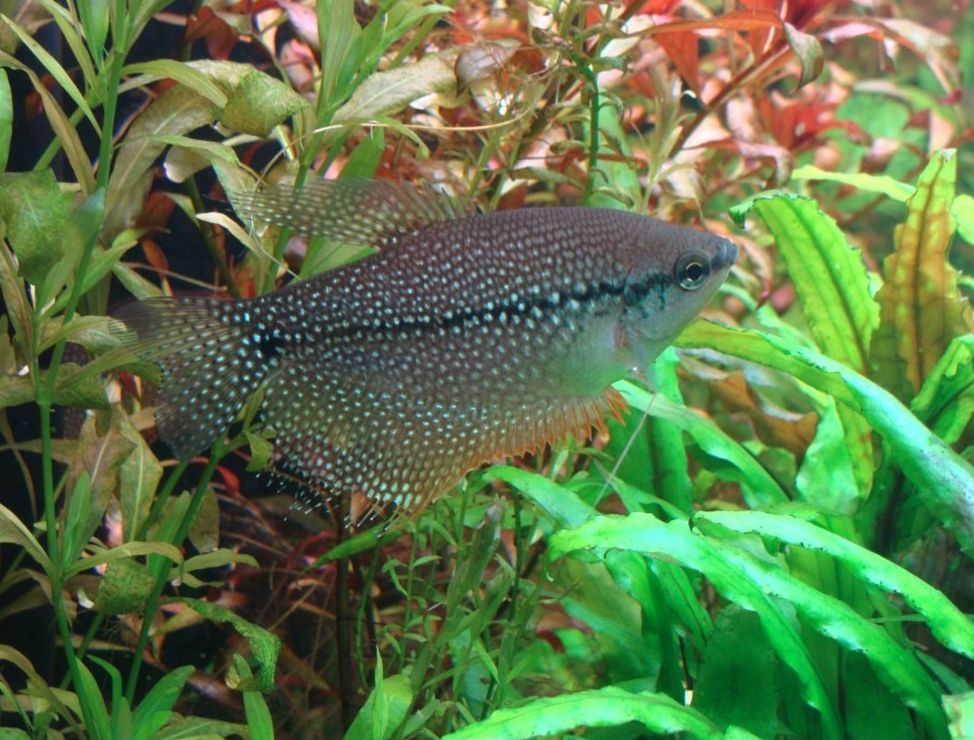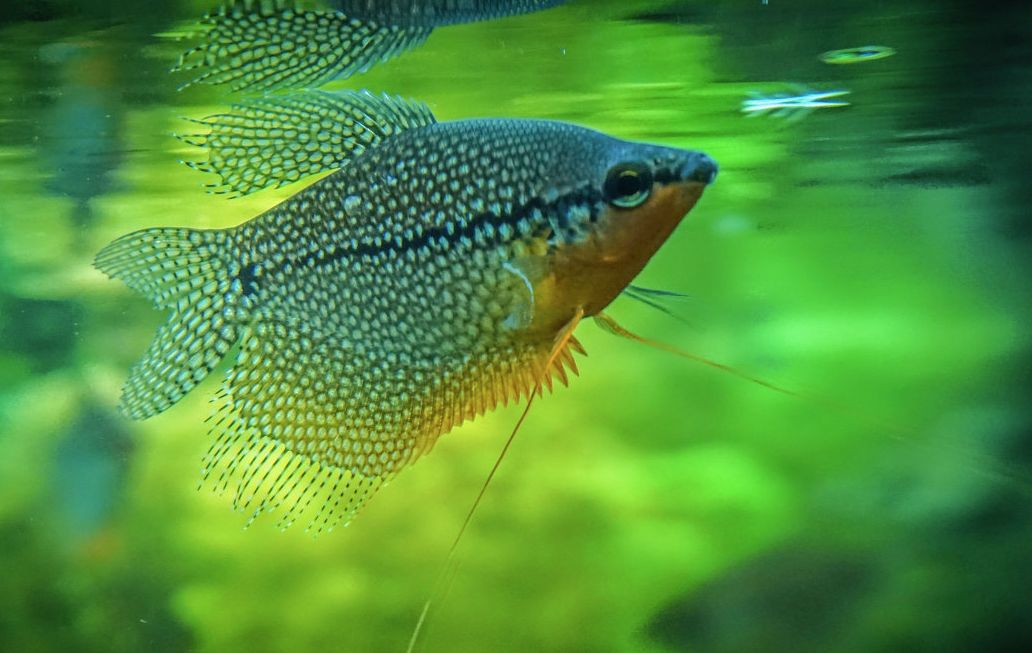The pearl gourami (lat. Trichopodus leerii) is a popular aquarium fish of the Osphronemidae family. This is one of the most beautiful gourami kinds. It is rather demanding to tank conditions. Reading further, you’ll find out what water parameters the fish fancies, how to feed it, how to select its tank mates, and to breed it.

Contents
Habitat in the wild
The pearl gourami (Trichogaster leeri) belongs to the family Osphronemidae, commonly known as the Gourami family. Gouramis are popular freshwater fish that are often kept in aquariums due to their vibrant colors, interesting behaviors, and relatively peaceful nature. The family Osphronemidae includes various species of gouramis, and they are native to Southeast Asia. Pearl gouramis, in particular, are known for their beautiful pearly iridescent scales and peaceful temperament, making them a favorite among aquarium enthusiasts.
In the wild, pearl gourami is encountered in South-East Asia: Thailand, the Malaysian peninsula, Indonesia (Sumatra and Kalimantan islands).
The fish dwells in shallow warm waters with thickly growing plants. These are mostly small lakes, bogs, slow river backwaters, and other lentic or slow-flowing waters. Quite often, their bottom is muddy with a layer of fallen leaves on it. Water parameters there are the following: pH values are 6.0—8.0, hardness 5—19°dH, temperature 22-28 °C (72–82 °F).
Nowadays, in some areas, especially in the central part of Thailand, there is an intense recultivation of swamplands that started in 1990. Therefore, the pearl gourami loses their natural habitat, and their population decreases. The same situation is observed in peninsular Malaysia. Pearl gourami areal is gradually getting smaller, which was the reason to put the fish into the category «Near Threatened.»
However, the existing situation doesn’t endanger the current aquarium fish market since their mass breeding has been organized both in Europe and the US.
Description
Lifespan
The average lifespan of pearl gouramis is typically around 4 to 6 years when kept in a well-maintained aquarium with proper care. However, with exceptional care, some individuals may live even longer, possibly up to 8 years or more. Like many other living beings, the lifespan of pearl gouramis can be influenced by factors such as genetics, diet, water quality, stress levels, and overall living conditions. Providing a suitable environment, balanced nutrition, and a stress-free atmosphere can help maximize the lifespan of these beautiful fish. Regular water changes and monitoring for any signs of illness or distress can also contribute to their long-term health and well-being.
Size
The male pearl gourami is up to 12 centimeters (4.7 in) long, and the female is slightly smaller. When living in a tank, the fish size doesn’t exceed 8-10 cm. As with many fish species, the size can vary depending on their environment, diet, and overall care provided. Proper tank size and water quality can also play a role in ensuring these fish reach their full potential size.
Body
The fish body is oval-shaped, elongated, and flattened from sides; the snout is pointed, the mouth is small. The pearl gourami has well-developed fins. The anal fin is especially large, the dorsal is short, and the abdominal fins are thin like filaments and very long. They act as a kind of tactile organs.
Color
The pearl gourami got its name due to the specific tessellated pattern consisting of many spots that resemble small pearls by their shape and color. The pearl gourami coloring is astonishing. It is silvery liliaceous with perlaceous spots that resemble real pearls (due to them, the fish got its name). These spots cover almost all the fish body, its anal, dorsal, and tail fins, except its head.
There is a black dash line that starts from the fish nose and stretches till the beginning of its tail fin; it becomes less pronounced as it gets closer to the fishtail. The fish back is brownish.
Labyrinth organ
Like other representatives of Trichopodus species, the pearl gourami can absorb atmospheric oxygen right from the air when gasping it near the water surface. The pearl gourami has an interesting peculiarity – they have a special organ called ‘a labyrinth’ due to its complicated shape, and the fish use it for breathing with atmospheric air.
The labyrinth organ is a system of channels in the cavity located in the fish mandibular arch dilatation. In this cavity, there are the tiniest bone lamellas covered with mucous membrane rich with blood vessels. The pearl gourami gasps the air with its mouth, it gets into the labyrinth, and this is where its blood oxygenation happens. This organ gives it the ability to survive without water for a long time or live in oxygen-deficient waters. Labyrinth organ develops only 2-3 weeks later after the larvae hatch from the eggs.
Gourami species have gills like all fishes, but they perform an auxiliary function. If you leave the fish without any access to the water surface for a long time, they will suffocate and die.
Due to this fact, the first attempts to bring these fish to Europe in the 19th century weren’t successful. They were caught in Thailand and Vietnam, but they couldn’t stand even a day on the way and inalterably died. These days, exotic fish transportation was rather traditional – they traveled in wooden barrels filled with water to the top. Very few people knew about climbing perch biology features then. Without any access to atmospheric air, the pearl gourami lived only till the time of the barrels embarking. After many vain attempts, they started considering the fish as troublesome, and their spreading to other countries was put on hold.
Spectators were puzzled since, in the wild, they caught the fish in rain barrels, watershoots, abandoned quarries with extremely dirty water. Then what was the problem, and what were they missing when transporting the fish? Only at the very end of the 19th century, some European, while observing them in a natural body of water, spotted that they rose to the water surface to gasp an air bubble from time to time. He filled the barrels used for the pearl gourami transporting with water but only 2/3 of their capacity, and he didn’t close them. As a result, several thousand pearl gourami were delivered to the destination without any loss.
| Characteristic | Description |
|---|---|
| Scientific Name | Trichogaster leeri |
| Common Name | Pearl Gourami |
| Family | Osphronemidae (Gourami family) |
| Origin | Southeast Asia: Thailand, Malaysia, Indonesia |
| Habitat | Slow-moving or still waters, densely vegetated with aquatic plants (lakes, ponds, slow rivers) |
| Maximum Size | 4 to 5 inches (10 to 12 cm) |
| Lifespan | 4 to 6 years (with proper care) |
| Temperament | Generally peaceful, may display territorial behavior |
| Water Parameters | Temperature: 75°F to 82°F (24°C to 28°C) |
| pH: 6.0 to 7.5 | |
| Water hardness: Soft to slightly acidic | |
| Diet | Omnivorous: flakes, pellets, live/frozen foods (brine shrimp, daphnia, bloodworms), veggie matter |
| Color | Pearl-like iridescent scales (silver/white). With hints of pink, blue, and green |
| Breeding | Bubble nest builder, paternal mouthbrooder |
| Compatibility | Generally peaceful, but avoid aggressive tankmates |
| Tank Size | Minimum 20 gallons (75 liters) for a pair |

Difficulties in keeping
The pearl gourami is a rather demanding fish, so it can’t be recommended for beginning aquarists. Of all gourami species, the pearl gourami is the most demanding one. The fish is very timid and more sensitive to temperature change or water contamination than opaline gourami.
Therefore if you are just taking a shot at aquarium husbandry, it’s better to choose some other fish. For example, a betta fish. However, nothing special is required to keep the fish. You just have to create proper tank conditions and have some experience.

Care and keeping in a tank
Tank size
The recommended tank size for a pearl gourami depends on several factors, including the number of fish and whether you plan to keep them in a community tank with other fish species. Pearl gouramis are relatively peaceful fish, but they can be territorial, especially during breeding or if they feel cramped in a small space.
For a single pearl gourami or a pair (one male and one female), a minimum tank size of 20 gallons (approximately 75 liters) is suitable.You can get a smaller tank, but you will have to decrease the number of fish correspondingly. At that, there should be more females than males to avoid the males’ rivalry.
If you want to keep a small community of pearl gouramis along with other peaceful fish, it’s best to have a larger tank to accommodate their social and territorial needs. A 30-gallon (approximately 113 liters) tank or larger would be more appropriate for a small group of pearl gouramis.
In larger tanks, you can create more natural and spacious environments with ample hiding spots and aquatic plants, which will help reduce stress and promote their well-being.
Water parameters
There are no special requirements for the tank water composition, but it’s better if the water is old and soft (up to 15 °dH), peat, and weak acidic (pH 6.0-7.0). It is important to maintain the tank clean since the species are very sensitive to various fungus and infectious diseases.
Preferable tank water parameters are the following:
- Temperature: 75°F to 82°F (24°C to 28°C)
Pearl Gouramis prefer a tropical environment with a relatively stable temperature. Make sure to use a reliable aquarium heater to maintain the water temperature within this range. - pH Level: 6.0 to 7.0
Pearl Gouramis thrive in slightly acidic to neutral water conditions. Regularly test the pH level and adjust it if necessary, but try to avoid rapid and drastic pH changes. - Water Hardness: Soft to slightly hard
The ideal water hardness for Pearl Gouramis is around 5 to 15 dGH (degrees of General Hardness). Soft water with a moderate level of hardness is suitable for these fish. - Ammonia, Nitrite, and Nitrate Levels:
Ammonia and nitrite levels should be kept at zero, as they are toxic to fish. Regularly test your aquarium water and perform water changes to keep these levels in check. Nitrate levels should also be maintained at a relatively low level (preferably below 20 ppm).
Tank setup: decorations and plants
Near the water surface, the air should be well-ventilated and warm to ensure that the pearl gourami won’t catch a cold. That’s why covering a tank is a must. The lid not only covers the water and prevents various objects from falling into it, from dust and rubbish ingress, but also it ensures the appearance of air layer with higher humidity and temperature. Such a layer decreases the chances of the fish labyrinth organ damage while gasping the atmospheric air.
The pearl gourami is a timid fish. It requires a thickly planted tank to feel comfortable. When decorating the tank, use tank plants with strong roots, put them along the back and side tank walls. Floating plants are also useful since they provide additional shadowing. The type of the bottom substrate isn’t important, but the pearl gourami looks more appealing when the background is dark-colored.
Filtration
Water filtration is desirable, but at the same time, it is important not to create excessive water flow because pearl gourami prefers slow waters. A good filtration system is essential to keep the water clean and free from harmful substances. Regularly clean the filter media to ensure it functions optimally. Additionally, perform regular water changes (about 20-30% every 1-2 weeks) to maintain excellent water quality.

Diet
The pearl gourami is omnivorous. In the wild, it feeds on insects, larvae, and zooplankton. The fish eats everything you give to it – live, frozen and artificial ones. You can base the fish diet on artificial food – flakes, pellets, etc. and use live and frozen food as supplementary components. These can be bloodworm, tubifex, brine shrimp. High digestibility of artificial food allows decreasing the amount of waste produced by the fish, and this way helps to maintain the tank water purity.
The only thing you should keep in mind is that it has a small mouth and therefore it won’t be able to swallow large-sized food. Also, the pearl gourami isn’t very brisk while feeding, so it’s important to watch that the fish gets enough food.
It is recommended to feed them several times a day with small portions. All food should be eaten in several minutes.
An interesting peculiarity of the fish is that it can eat hydra. This is a small coelenterate that has poisonous tentacles. In a tank, it can prey on fish, juveniles, and small fishes. Of course, the hydra is an unwanted guest in a tank, and gourami species will help you get rid of it.

Tank mates
Pearl gourami swims slowly and creates a calm atmosphere in a tank. The fish has a peaceful, timid temper and gets on well with its tank mates. You can’t keep the fish together with active or aggressive fish species.
This is the most peaceful gourami species and will not eat small fish, making it a perfect dweller of a not very crowded community tank. At that, since the pearl gourami is timid, it may hide till it makes itself at home.
The best tank mates for pearl gourami are fishes of equal size and behavior. It’s better to keep this gourami species together with dwarf gouramis or honey gouramis. But keep in mind that other gourami species (like opaline gourami or paradise fish) may demonstrate aggression towards its kind. You can also keep it with betta fish, but they have unpredictable and quarrelsome behavior and are quite capable of haunting timid pearl gourami. Therefore it’s better to avoid such tank mates.
Although its intraspecific bellicosity angelfish will be a good tank mate for pearl gourami, the fish shows good compatibility with neon tetra, guppies, harlequin rasbora, bolivian ram, and other small fishes.
You can also keep this gourami with shrimps, but only with large ones (like Amano shrimp) because the fish will treat small cherry shrimp as food. Gourami won’t eat a lot of shrimps, but if you need them in a tank, then it’s better not to keep these together in one tank.
Gender differences: male vs female
Here are some general characteristics to help differentiate between male and female pearl gouramis:
Male Pearl Gourami:
- Larger and more elongated body: The pearl gourami males are noticeably larger, stronger, and slimmer than females.
- Pointed dorsal fin: They have larger fins and much brighter coloring. The fish dorsal, like that of all Trichopodus kind species, is elongated and pointed.
- Intense coloration: The throat, chest, abdominal fins, front side of the anal fin of the male fish are orange or even red. Red color becomes even more saturated during the spawning period, and when the fish is excited and the coloring becomes brighter as the fish gets older.
- Vertical stripes: Males may have vertical stripes on their bodies that become more pronounced during courtship and territorial displays.
Female Pearl Gourami:
- Rounded dorsal fin: The dorsal fin of female Pearl Gouramis is typically more rounded and shorter compared to males.
- Less intense coloration: Females usually have more subdued colors compared to males, with less vibrant markings and less intense patterns.
- Rounded abdomen: Mature females may have a slightly more rounded abdomen, especially when carrying eggs.
It’s important to note that these differences may not be entirely reliable, especially in younger or stressed individuals. The best way to determine the sex of your pearl gouramis is to observe their behavior during breeding conditions or consult with an experienced aquarist or a knowledgeable fish store expert. Males are generally more colorful and visually appealing, but having a mix of males and females can create a more balanced and harmonious community aquarium.
Breeding
Pearl gourami breeding is more difficult than that of the rest of the gourami species. You will need a tank of at least 30 liters large, but considering the high fertility of the fish, it’s better to have a 50-60 liters tank; the water level shouldn’t exceed 25-35 cm.
The water should be old and soft (up to 7°dH), pH around 7.0, water temperature within 27-32 °C. The spawning tank should be decorated the same way as the initial tank where the fish lives. It is desirable to put a bunch of riccia into it.
It is important to make sure that the pearl gourami feels safe and nothing disturbs it. Therefore, put the spawning tank in a quiet place and cover the glass walls. Spawning is performed in couples. It is recommended to take young fish (starting from 8 months old) with bright coloring. Keep the male and female fish separately for a week and feed them well with various live food to prepare for spawning.
The male fish is the first to be put into the spawning tank and then several hours later put a female fish. To trigger the spawning process renew 1/5-1/3 of the tank water with the fresh one and raise its temperature by 2-3 °C. Don’t feed the pearl gourami during this time and only two days later, start to feed them with small portions of well-washed bloodworm or tubifex.
As the spawning comes, the male fish becomes more aggressive. Therefore the female fish should have shelter in a tank. The male builds a bubble nest from air bubbles, plant pieces, and saliva on the water surface.
The nest of pearl gourami is low and large. Sometimes the fish can spawn even without a nest. As a rule, spawning occurs on the second day of the fish stay in the spawning tank, and it lasts about 2 hours. The fish lays eggs in portions. Each time the pearl gourami lays eggs under the nest, the male fish holds the female and turns it with her abdomen up.
Pearl gourami eggs have a fatty cover and bob up to the water surface at once. The male fish gathers them and puts them into the nest. The fish lays about 600—700 eggs at a time, though their number may be up to 2000.
The female pearl gourami is removed from the tank right after the spawning is over; the male is left to look after the offspring. He fixes the nest and gathers the eggs together all the time. The egg stage lasts about 1-2 days. After that, the larvae appear.
The latter is very small, and it has a yolk bag with some amount of nutrients that is enough for 2-4 days. After this, the larvae turn into juveniles and start to swim and feed. They don’t need the male pearl gourami anymore, and you can take him out from the spawning tank.
The water level should be decreased up to 6-10 cm, and you have to keep it like this for about a month, till the young fish starts using its labyrinth organ (they’ll start gasping air from the water surface).
Juveniles are very small. First 5-6 days, you can feed them with infusorian, then add zooplankton into their diet. If there are a lot of juveniles in a tank, some aeration is required.
The tank should be ideally clean. Gourami can spawn about 3-4 times in a season, and they stay reproductive up to the age of 5 years old.